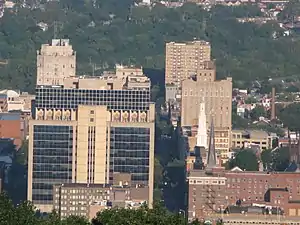Delaware Valley
The Delaware Valley is a metropolitan region on the East Coast of the United States that comprises and surrounds Philadelphia, the sixth most populous city in the nation as of 2020 and 68th largest city in the world. The Delaware Valley region includes portions of four U.S. states (Delaware, Maryland, New Jersey, and Pennsylvania) and four regions in the area (Southeastern Pennsylvania, South Jersey, northern Delaware, and the northern Eastern Shore of Maryland) along the central and lower Delaware River. The Delaware Valley has a total 2020 population of 6.245 million, making it the seventh largest metropolitan region in the United States and 35th largest metropolitan region in the world.
Delaware Valley
Greater Philadelphia Southeastern Pennsylvania Philadelphia-Camden-Wilmington, PA-NJ-DE-MD MSA | |
|---|---|
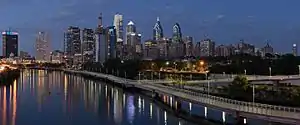 Philadelphia in July 2016 | |
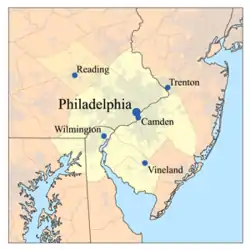 Map of the Lower Delaware Valley Metropolitan Area. In addition to the yellow-shaded area, other parts of South Jersey (namely, Atlantic County and Cape May County) and Delaware (such as Dover) are considered to be part of the Delaware Valley or Philadelphia Metropolitan Area. | |
| Country | |
| State | - - - - |
| Principal cities and towns | Philadelphia Camden Wilmington Atlantic City Reading Trenton[lower-alpha 1] Vineland Conshohocken Dover Chester Upper Darby Media Middletown Township Hammonton Norristown Doylestown Cherry Hill West Chester Evesham Washington Township Millville Salem Cape May Court House Lower Township The Wildwoods Brigantine Ventnor City Margate City Ocean City Sea Isle City Haverford Bridgeton Coatesville Lower Merion Gloucester Township Downingtown Phoenixville Pottstown King of Prussia Bensalem Township Burlington City and Burlington Township Mount Holly Newark Hamilton Township (Mays Landing) Woodbury Elkton Cheltenham Abington Township Bristol Township Mount Laurel Northampton Township Winslow Township |
| Area | |
| • Urban | 1,981.4 sq mi (5,131.7 km2) |
| • Metro | 5,118 sq mi (13,256 km2) |
| Elevation | 0 - 1,080 ft (0 - 329 m) |
| Population (2021 est.) | |
| • Urban | 5,441,567 (5th) |
| • Metro density | 1,217.00/sq mi (469.89/km2) |
| • MSA | 6,228,601 (7th) |
| • CSA | 7,366,346 (9th) |
| MSA/CSA = 2021, Urban = 2010 | |
| Time zone | UTC−5 (EST) |
| • Summer (DST) | UTC−4 (EST) |
Philadelphia is by far the largest municipality in the Delaware Valley and serves as the region's major commercial, cultural, educational, and industrial center. Other major urban population centers in the Delaware Valley include the cities of Reading, Upper Darby Township, and Chester in Pennsylvania; Atlantic City, Camden, Vineland, and Cherry Hill in New Jersey; and Wilmington and Dover in Delaware. The Delaware Valley Metropolitan Area is located in the Northeastern United States and forms part of the Northeast megalopolis, the most populated region of the nation with over 50 million residents. According to the Bureau of Economic Analysis, the Philadelphia metropolitan area has a gross domestic product of $431 billion, the ninth-largest among U.S. metropolitan areas.
The Delaware Valley has been influential in American history and industry. The area has hosted many people and sites significant to American culture, history, and politics. Philadelphia is sometimes known as "The Birthplace of America",[3] as both the Declaration of Independence and the Constitution were drafted and signed in Philadelphia. The Delaware Valley was home to many other instrumental moments in the American Revolution, and Philadelphia served as the capital of the United States for much of the 18th century.
The region is home to a number of nationally known universities, including the University of Pennsylvania in Philadelphia, one of the top universities in the world.[4][5][6] Other regional universities and colleges include Drexel University, Thomas Jefferson University, Villanova University, Saint Joseph's University, Temple University, Rutgers University–Camden, La Salle University, the University of Delaware, and others.[7] Philadelphia and the Delaware Valley have become a biotechnology[8] and venture capital hub.
Geography
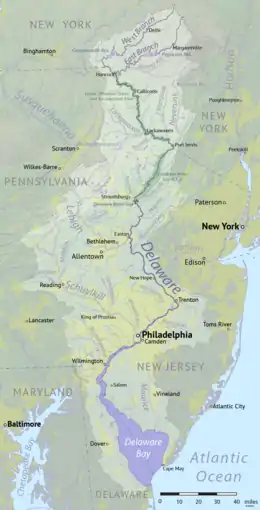
The Delaware Valley is geographically associated and proximate to the Delaware River's main watershed, which encompass the Delaware River's two primary tributaries, the Schuylkill and Lehigh Rivers, and their respective valleys and sub-basins. These extensions also apply culturally because the ease of land travel in the region affords a great deal of daily interaction, creating a regional culture and value structure that largely blends and is parallel throughout it.
Definitions of the metropolitan area
In the course of their work, U.S. government agencies have reached various definitions of the Delaware Valley and the Greater Philadelphia Area.
The Office of Management and Budget (OMB) defines metropolitan statistical area (MSAs), which are regions with relatively high population densities at their cores and close economic ties throughout their respective areas. MSAs are further combined into CSAs (combined statistical areas), reflecting commuting patterns. Neither is a formal administrative division.
Metropolitan statistical area (MSA)
| Historical population | |||
|---|---|---|---|
| Census | Pop. | %± | |
| 1820 | 171,430 | — | |
| 1830 | 228,203 | 33.1% | |
| 1840 | 305,278 | 33.8% | |
| 1850 | 467,053 | 53.0% | |
| 1860 | 636,029 | 36.2% | |
| 1870 | 841,230 | 32.3% | |
| 1880 | 1,062,677 | 26.3% | |
| 1890 | 1,391,157 | 30.9% | |
| 1900 | 1,892,496 | 36.0% | |
| 1910 | 2,268,209 | 19.9% | |
| 1920 | 2,714,271 | 19.7% | |
| 1930 | 3,137,040 | 15.6% | |
| 1940 | 3,299,637 | 5.2% | |
| 1950 | 3,671,048 | 11.3% | |
| 1960 | 4,757,462 | 29.6% | |
| 1970 | 5,317,407 | 11.8% | |
| 1980 | 5,240,039 | −1.5% | |
| 1990 | 5,435,468 | 3.7% | |
| 2000 | 5,687,147 | 4.6% | |
| 2010 | 5,965,343 | 4.9% | |
| 2020 | 6,245,051 | 4.7% | |
| U.S. Decennial Census | |||
Philadelphia is located in the Philadelphia-Camden-Wilmington Metropolitan Statistical Area, which includes:[9]
- Camden, NJ Metropolitan Division
- Burlington County
- Camden County
- Gloucester County
- Montgomery County-Bucks County-Chester County, PA Metropolitan Division
- Bucks County
- Chester County
- Montgomery County
- Philadelphia, PA Metropolitan Division
- Delaware County
- Philadelphia County
- Wilmington, DE-MD-NJ Metropolitan Division
- New Castle County, Delaware
- Cecil County, Maryland
- Salem County, New Jersey
Combined statistical area (CSA)
The Philadelphia-Reading-Camden Combined Statistical Area includes [9]
- The Philadelphia-Camden-Wilmington MSA (eleven counties, as defined above)
- Berks County, Pennsylvania, comprising the Reading, PA MSA
- Kent County, Delaware, comprising the Dover, DE MSA
- Atlantic County, New Jersey, comprising the Atlantic City-Hammonton, NJ MSA
- Cape May County, New Jersey, comprising the Ocean City, NJ MSA
- Cumberland County, New Jersey, comprising the Vineland-Bridgeton, NJ MSA
Counties not in the Philadelphia metropolitan area
Some counties to the north of the Philadelphia MSA and CSA, such as Hunterdon County, New Jersey, lie partly in the Delaware Valley as a geographic concept, that is, the drainage basin of the Delaware River. Local businesses and the Delaware Valley Regional High School carry the name. However, Hunterdon County does not belong to the Philadelphia CSA, but rather to the New York-Northern New Jersey-Long Island Metropolitan Statistical Area (MSA), part of the larger New York-Newark Combined Statistical Area (CSA).[9]
Regional Planning Commission
The Delaware Valley Regional Planning Commission (DVRPC) serves all of the counties of the MSA above, except for the counties in the Wilmington, DE-MD-NJ Metropolitan Division. However the DVRPC does include, additionally, Mercer County, New Jersey, which the OMB classifies as the Trenton-Princeton, NJ MSA, part of the larger New York-Newark CSA.[10]
Population and economy
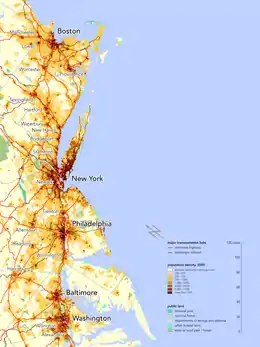
According to 2016 estimates from the United States Census Bureau, the Philadelphia-Camden-Wilmington Metropolitan Statistical Area ranks as the seventh-largest MSA in the United States with 6,070,500 people.[11] According to the Bureau of Economic Analysis, the Philadelphia-Camden-Wilmington MSA had a gross domestic product of $431 billion, the ninth-largest among U.S. metropolitan areas.[12] 2016 Census Bureau estimates rank the Philadelphia-Reading-Camden Combined Statistical Area as the ninth-largest CSA in the United States, with 7,179,357 people.[13]
The Philadelphia-Camden-Wilmington Metropolitan Statistical Area's population of roughly 6 million people is comparable to that of countries such as Lebanon, Denmark, and Nicaragua. The MSA's nominal gross domestic product of $431 billion is comparable to countries such as Belgium, Iran, and Thailand. The MSA also ranks as the second most populous in the Northeastern United States after the New York metropolitan area, while the CSA is third-largest in the Northeast after the New York and Boston metropolitan areas. The Baltimore–Washington metropolitan area, which is part of Northeast Megalopolis but is considered part of the Southeastern United States under Census Bureau definitions, is also larger than the Philadelphia metropolitan area. Philadelphia itself is the sixth-most populous city in the United States and the third-most populous U.S. city east of the Mississippi River, after New York City and Chicago. Philadelphia's media market ranks fourth, behind New York City, Los Angeles, and Chicago, in Nielsen Media Market size rankings.[14]
Such educational institutions as Delaware Valley Regional High School in Alexandria Township and Delaware Valley College in Doylestown Township are named after the region. Likewise, Frenchtown's now defunct newspaper The Delaware Valley News was another example of the usage.
Subregions
Sixteen counties in four states constitute the Philadelphia-Reading-Camden Combined Statistical Area. The five Pennsylvania counties in the MSA are collectively known as Southeastern Pennsylvania, and the four suburban counties from this region are sometimes called the "collar counties."[15] Aside from Philadelphia, major municipalities in Southeastern Pennsylvania include the inner suburbs of Upper Darby Township and Bensalem Township. Berks County, which forms its own MSA and contains the CSA's second largest city, Reading, is generally not considered to be part of Southeastern Pennsylvania and is sometimes assigned to South Central Pennsylvania.
The seven New Jersey counties in the CSA form South Jersey, although Ocean County, which is part of the New York CSA, is also sometimes considered to be part of South Jersey.[16] Atlantic County, Cape May County, and Cumberland County each form their own respective metropolitan statistical areas. Atlantic City, Cape May County, and the southern Jersey Shore (including Margate City, Ventnor City, the Wildwoods, and Sea Isle City) are major tourist destinations for people from inside and outside of the Delaware Valley. Other major municipalities in South Jersey include Cherry Hill and Camden, which is across the Delaware River from Philadelphia.
The two counties of Delaware in the CSA constitute a majority of Delaware's land mass and population. Wilmington is the most populous city in Delaware and the fifth-most populous municipality in the Delaware Valley. The lone Maryland county in the Philadelphia-Reading-Camden Combined Statistical Area is part of the region known as the Eastern Shore of Maryland.
Although Mercer County in Central Jersey is often considered part of the Delaware Valley from a cultural perspective, it is classified as part of New York's CSA by the OMB. Mercer County and three counties in Pennsylvania's Lehigh Valley, Carbon County, Lehigh County and Northampton County, are part of the Philadelphia media market. Caroline County, Maryland is also part of the Philadelphia media market, and other counties within the Philadelphia media market include Monroe County, Pennsylvania, Lancaster County, Pennsylvania, and Ocean County, New Jersey.[17]
Components of Philadelphia-Camden-Wilmington, PA-NJ-DE-MD Metropolitan Statistical Area
| County | 2021 Estimate | 2020 Census | Change | Area | Density |
|---|---|---|---|---|---|
| Philadelphia County | 1,576,251 | 1,603,797 | −1.72% | 134.28 sq mi (347.8 km2) | 11,739/sq mi (4,532/km2) |
| Montgomery County | 860,578 | 856,553 | +0.47% | 483 sq mi (1,250 km2) | 1,782/sq mi (688/km2) |
| Bucks County | 646,098 | 646,538 | −0.07% | 604 sq mi (1,560 km2) | 1,070/sq mi (413/km2) |
| Delaware County | 573,849 | 576,830 | −0.52% | 184 sq mi (480 km2) | 3,119/sq mi (1,204/km2) |
| New Castle County | 571,708 | 570,719 | +0.17% | 426 sq mi (1,100 km2) | 1,342/sq mi (518/km2) |
| Chester County | 538,649 | 534,413 | +0.79% | 751 sq mi (1,950 km2) | 717/sq mi (277/km2) |
| Camden County | 523,771 | 523,485 | +0.05% | 221.26 sq mi (573.1 km2) | 2,367/sq mi (914/km2) |
| Burlington County | 464,269 | 461,860 | +0.52% | 798.58 sq mi (2,068.3 km2) | 581/sq mi (224/km2) |
| Gloucester County | 304,477 | 302,294 | +0.72% | 322 sq mi (830 km2) | 946/sq mi (365/km2) |
| Cecil County | 103,905 | 103,725 | +0.17% | 346 sq mi (900 km2) | 300/sq mi (116/km2) |
| Salem County | 65,046 | 64,837 | +0.32% | 331.9 sq mi (860 km2) | 196/sq mi (76/km2) |
| Total MSA Population | 6,228,601 | 6,245,051 | −0.26% | 4,602.02 sq mi (11,919.2 km2) | 1,353/sq mi (523/km2) |
Additional Components of Philadelphia-Camden-Vineland, PA-NJ-DE-MD Combined Statistical Area
| County | 2021 Estimate | 2020 Census | Change | Area | Density |
|---|---|---|---|---|---|
| Berks County | 429,342 | 428,849 | +0.11% | 857 sq mi (2,220 km2) | 501/sq mi (193/km2) |
| Atlantic County | 274,966 | 274,534 | +0.16% | 555.7 sq mi (1,439 km2) | 495/sq mi (191/km2) |
| Kent County | 184,149 | 181,851 | +1.26% | 586 sq mi (1,520 km2) | 314/sq mi (121/km2) |
| Cumberland County | 153,627 | 154,152 | −0.34% | 483.7 sq mi (1,253 km2) | 318/sq mi (123/km2) |
| Cape May County | 95,661 | 95,263 | +0.42% | 251.42 sq mi (651.2 km2) | 380/sq mi (147/km2) |
| Total CSA Population | 7,366,346 | 7,379,700 | −0.18% | 7,335.84 sq mi (18,999.7 km2) | 1,004/sq mi (388/km2) |
List of largest municipalities
.jpg.webp)
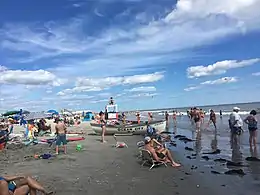
These municipalities are all within the Philadelphia-Reading-Camden Combined Statistical Area.
| City | Pop.[18] | County | State |
|---|---|---|---|
| Philadelphia | 1,567,872 | Philadelphia | PA |
| Reading | 87,575 | Berks | PA |
| Upper Darby Township | 82,765 | Delaware | PA |
| Camden | 74,420 | Camden | NJ |
| Wilmington | 71,502 | New Castle | DE |
| Cherry Hill | 70,976 | Camden | NJ |
| Gloucester Township | 64,049 | Camden | NJ |
| Vineland | 60,876 | Cumberland | NJ |
| Bensalem Township | 60,354 | Bucks | PA |
| Lower Merion Township | 58,220 | Montgomery | PA |
| Abington Township | 55,640 | Montgomery | PA |
| Bristol Township | 54,170 | Bucks | PA |
| Haverford Township | 48,893 | Delaware | PA |
| Washington Township | 48,301 | Gloucester | NJ |
| Evesham Township | 45,578 | Burlington | NJ |
| Middletown Township | 45,318 | Bucks | PA |
| Egg Harbor Township | 43,747 | Atlantic | NJ |
| Mount Laurel | 41,849 | Burlington | NJ |
| Northampton Township | 39,562 | Bucks | PA |
| Winslow Township | 39,417 | Camden | NJ |
Statistical history
When metropolitan areas were originally defined in 1950, most of the area now in the Delaware Valley was split between four metropolitan areas, or "standard metropolitan areas," as they were called. The Philadelphia SMA comprised Philadelphia, Bucks, Chester, Delaware and Montgomery counties in Pennsylvania and Burlington, Camden and Gloucester counties in New Jersey. The Wilmington SMA comprised New Castle County in Delaware and Salem County in New Jersey, while Berks County was the Reading SMA and Atlantic County was the Atlantic City SMA.
In 1960, Cecil County was added to what was now the Wilmington Standard Metropolitan Statistical Area (SMSA). In 1980, Cumberland County was defined as the Vineland-Millville-Bridgeton SMSA.
In 1990, the Philadelphia, Wilmington and Vineland-Millville-Bridgeton SMSAs were merged with the Trenton SMSA as the Philadelphia-Wilmington-Trenton Consolidated Metropolitan Statistical Area. At the same time, Cape May County was added to the Atlantic City SMSA. "Philadelphia-Wilmington-Trenton" became obsolete one census later, with Trenton moving to the New York-Newark-Bridgeport CSA, and the Philadelphia-Wilmington-Vineland CSA consisting only of the Philadelphia-Wilmington-Camden MSA and the Vineland-Millville-Bridgeton MSA.[19] Kent County became the Dover MSA in 2000, and it and Atlantic City were added to the Philadelphia CSA in 2010, for a total of six MSA components; as a result of new 2010 definitions based on a threshold of 15% labor interchange between MSAs, two more MSAs were added to the CSA, for a total of six. With Ocean City, NJ, and Reading, PA, the CSA is now known as Philadelphia-Reading-Camden.[20]
Characteristics
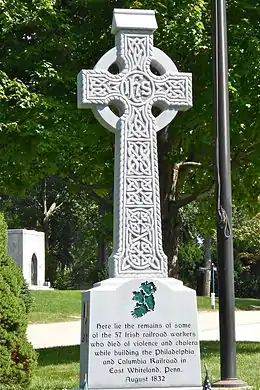


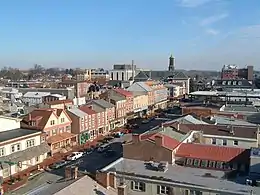
The Delaware Valley is home to extensive populations of Irish Americans, German Americans, English Americans, Ukrainian Americans, Italian Americans, Swedish-Americans (which have a museum located at FDR Park in South Philadelphia), Polish Americans, Scottish Americans, Ulster Scot or "Scotch-Irish" Americans, Welsh Americans, Jewish Americans, Greek Americans, African Americans, Chinese Americans, Indian Americans, Russian Americans, Korean Americans, Vietnamese Americans, Armenian Americans, Arab Americans, Turkish Americans, Pakistani Americans, Israeli Americans, various African immigrant groups, particularly from West African; various West Indian American groups, including Jamaican Americans; and Hispanic Americans. Within the Hispanic population, the vast majority are Puerto Ricans, though other significant groups include Dominican Americans and Mexican Americans, as well as significant populations from Central America.[22] There is even a small Native American community known as Lenapehoking for Lenni-Lenape Indians of West Philadelphia.
Philadelphia's suburbs contain a high concentration of malls, the two largest of which have at least 5,000,000 square feet (460,000 m2) of office space, and at least 600,000 square feet (56,000 m2) of retail. These are the King of Prussia mall in King of Prussia, Pennsylvania, which is the largest in the United States (leasable sq. feet of retail space), and the Cherry Hill Mall in Cherry Hill, New Jersey, which was the first enclosed mall on the East Coast. In addition, the Christiana Mall in Newark, DE is a popular destination due to its proximity to Interstate 95 and because of the availability of tax-free shopping in Delaware. Malls, office complexes, strip shopping plazas, expressways, and tract housing are common sights, and more and more continue to replace rolling countryside, farms, woods, and wetlands. However, due to strong opposition by residents and political officials, many acres of land have been preserved throughout the Delaware Valley. Older townships and large boroughs such as Cheltenham, Norristown, Jenkintown, Upper Darby and West Chester retain distinct community identities while engulfed in suburbia. The fastest-growing counties are Chester, Montgomery, Bucks, and Gloucester. Upper Darby, in Delaware County is the largest township in the United States. Sometimes Reading is included in the Delaware Valley Metro Area.
Mid-Atlantic American English and its subset, Philadelphia English, are two common dialects of American English in Philadelphia and the Delaware Valley.
Climate
The Delaware Valley has four distinct seasons with ample precipitation and is divided by the 0 °C (32 °F) January isotherm. Philadelphia and the New Jersey portion of the area, almost all of the Delaware and Maryland portions, most of Delaware County and lower Bucks County, lowland southern Chester County, and some southern and lowland areas of Montgomery County have a humid subtropical climate (Cfa according to the Köppen climate classification.) The remainder of the Delaware Valley has a hot-summer humid continental climate (Dfa.) Snow amounts may vary widely year-to-year and normally do vary widely within the Delaware Valley.
The region has only two ski areas: Bear Creek Mountain Resort in Macungie in the Lehigh Valley and Spring Mountain Adventures in central Montgomery County. Global warming endangers skiing at the latter, where the climate narrowly remains Dfa and the owners have diversified to year-round activities.
Using the -3 °C January isotherm as a boundary, all of the Delaware Valley is humid subtropical except for portions of Berks County and higher areas of northern Chester County. The warm-summer humid continental climate (Dfb) only exists in higher areas of Berks where all monthly temperatures average below 22 °C. The hardiness zone in the region ranges from 6a in higher areas of Berks to 8a in parts of Atlantic City and Cape May.
Using the Trewartha climate classification system, which requires eight months to average at least 50°F for the climate to be considered subtropical, the region only has seven such months, so the areas considered Cfa by Köppen are oceanic (Do) in the Trewartha system.
| Month | Jan | Feb | Mar | Apr | May | Jun | Jul | Aug | Sep | Oct | Nov | Dec | Year |
|---|---|---|---|---|---|---|---|---|---|---|---|---|---|
| Record high °F (°C) | 74 (23) |
79 (26) |
87 (31) |
95 (35) |
97 (36) |
102 (39) |
104 (40) |
106 (41) |
102 (39) |
96 (36) |
84 (29) |
73 (23) |
106 (41) |
| Mean maximum °F (°C) | 63.3 (17.4) |
63.5 (17.5) |
73.8 (23.2) |
84.3 (29.1) |
90.2 (32.3) |
94.8 (34.9) |
97.1 (36.2) |
94.8 (34.9) |
90.6 (32.6) |
82.6 (28.1) |
72.4 (22.4) |
64.2 (17.9) |
98.1 (36.7) |
| Average high °F (°C) | 41.3 (5.2) |
44.3 (6.8) |
52.8 (11.6) |
64.7 (18.2) |
74.4 (23.6) |
83.2 (28.4) |
87.8 (31.0) |
85.8 (29.9) |
78.9 (26.1) |
67.2 (19.6) |
55.9 (13.3) |
46.0 (7.8) |
65.2 (18.4) |
| Daily mean °F (°C) | 33.7 (0.9) |
35.9 (2.2) |
43.6 (6.4) |
54.5 (12.5) |
64.3 (17.9) |
73.5 (23.1) |
78.7 (25.9) |
76.8 (24.9) |
69.9 (21.1) |
58.2 (14.6) |
47.4 (8.6) |
38.6 (3.7) |
56.3 (13.5) |
| Average low °F (°C) | 26.0 (−3.3) |
27.5 (−2.5) |
34.3 (1.3) |
44.3 (6.8) |
54.2 (12.3) |
63.9 (17.7) |
69.6 (20.9) |
67.9 (19.9) |
60.9 (16.1) |
49.2 (9.6) |
38.8 (3.8) |
31.2 (−0.4) |
47.3 (8.5) |
| Mean minimum °F (°C) | 10.7 (−11.8) |
13.7 (−10.2) |
20.8 (−6.2) |
33.0 (0.6) |
43.1 (6.2) |
53.2 (11.8) |
62.2 (16.8) |
60.3 (15.7) |
49.5 (9.7) |
37.1 (2.8) |
26.4 (−3.1) |
19.0 (−7.2) |
8.6 (−13.0) |
| Record low °F (°C) | −7 (−22) |
−11 (−24) |
5 (−15) |
14 (−10) |
28 (−2) |
44 (7) |
51 (11) |
44 (7) |
35 (2) |
25 (−4) |
8 (−13) |
−5 (−21) |
−11 (−24) |
| Average precipitation inches (mm) | 3.13 (80) |
2.75 (70) |
3.96 (101) |
3.47 (88) |
3.34 (85) |
4.04 (103) |
4.38 (111) |
4.29 (109) |
4.40 (112) |
3.47 (88) |
2.91 (74) |
3.97 (101) |
44.11 (1,120) |
| Average snowfall inches (cm) | 7.1 (18) |
8.4 (21) |
3.6 (9.1) |
0.3 (0.76) |
0.0 (0.0) |
0.0 (0.0) |
0.0 (0.0) |
0.0 (0.0) |
0.0 (0.0) |
0.0 (0.0) |
0.2 (0.51) |
3.5 (8.9) |
23.1 (59) |
| Average precipitation days (≥ 0.01 in) | 11.0 | 9.7 | 10.9 | 10.9 | 11.0 | 10.3 | 10.1 | 8.9 | 9.3 | 9.1 | 8.6 | 11.0 | 120.8 |
| Average snowy days (≥ 0.1 in) | 4.1 | 3.8 | 2.0 | 0.2 | 0.0 | 0.0 | 0.0 | 0.0 | 0.0 | 0.0 | 0.1 | 1.8 | 12.0 |
| Average relative humidity (%) | 66.2 | 63.6 | 61.7 | 60.4 | 65.4 | 67.8 | 69.6 | 70.4 | 71.6 | 70.8 | 68.4 | 67.7 | 67.0 |
| Average dew point °F (°C) | 19.8 (−6.8) |
21.0 (−6.1) |
28.6 (−1.9) |
37.0 (2.8) |
49.5 (9.7) |
59.2 (15.1) |
64.6 (18.1) |
63.7 (17.6) |
57.2 (14.0) |
45.7 (7.6) |
35.6 (2.0) |
25.5 (−3.6) |
42.3 (5.7) |
| Mean monthly sunshine hours | 155.7 | 154.7 | 202.8 | 217.0 | 245.1 | 271.2 | 275.6 | 260.1 | 219.3 | 204.5 | 154.7 | 137.7 | 2,498.4 |
| Percent possible sunshine | 52 | 52 | 55 | 55 | 55 | 61 | 61 | 61 | 59 | 59 | 52 | 47 | 56 |
| Average ultraviolet index | 2 | 3 | 4 | 6 | 8 | 9 | 9 | 8 | 6 | 4 | 2 | 2 | 5 |
| Source 1: NOAA (relative humidity, dew point and sun 1961–1990)[26][27][24] | |||||||||||||
| Source 2: Weather Atlas (UV index)[28] | |||||||||||||
| Climate data for Philadelphia | |||||||||||||
|---|---|---|---|---|---|---|---|---|---|---|---|---|---|
| Month | Jan | Feb | Mar | Apr | May | Jun | Jul | Aug | Sep | Oct | Nov | Dec | Year |
| Average sea temperature °F (°C) | 41.8 (5.5) |
39.9 (4.4) |
41.2 (5.1) |
46.7 (8.2) |
53.9 (12.2) |
66.3 (19.0) |
74.0 (23.3) |
75.9 (24.4) |
71.4 (21.9) |
64.2 (17.9) |
55.1 (12.8) |
47.7 (8.8) |
56.5 (13.6) |
| Mean daily daylight hours | 10.0 | 11.0 | 12.0 | 13.0 | 14.0 | 15.0 | 15.0 | 14.0 | 12.0 | 11.0 | 10.0 | 9.0 | 12.2 |
| Source: Weather Atlas [28] | |||||||||||||
| Climate data for Atlantic City, New Jersey (downtown), 1991–2020 normals,[lower-alpha 4] extremes 1874–present[lower-alpha 5] | |||||||||||||
|---|---|---|---|---|---|---|---|---|---|---|---|---|---|
| Month | Jan | Feb | Mar | Apr | May | Jun | Jul | Aug | Sep | Oct | Nov | Dec | Year |
| Record high °F (°C) | 72 (22) |
77 (25) |
86 (30) |
91 (33) |
95 (35) |
99 (37) |
102 (39) |
104 (40) |
94 (34) |
91 (33) |
80 (27) |
74 (23) |
104 (40) |
| Mean maximum °F (°C) | 60 (16) |
60 (16) |
68 (20) |
77 (25) |
84 (29) |
90 (32) |
93 (34) |
91 (33) |
86 (30) |
79 (26) |
69 (21) |
62 (17) |
95 (35) |
| Average high °F (°C) | 41.6 (5.3) |
43.1 (6.2) |
48.4 (9.1) |
57.1 (13.9) |
65.7 (18.7) |
75.0 (23.9) |
80.3 (26.8) |
79.2 (26.2) |
74.0 (23.3) |
64.9 (18.3) |
54.9 (12.7) |
46.6 (8.1) |
60.9 (16.1) |
| Daily mean °F (°C) | 35.8 (2.1) |
37.2 (2.9) |
42.6 (5.9) |
51.4 (10.8) |
60.3 (15.7) |
69.9 (21.1) |
75.4 (24.1) |
74.8 (23.8) |
69.3 (20.7) |
59.3 (15.2) |
49.0 (9.4) |
40.9 (4.9) |
55.5 (13.1) |
| Average low °F (°C) | 29.9 (−1.2) |
31.3 (−0.4) |
36.9 (2.7) |
45.6 (7.6) |
54.9 (12.7) |
64.8 (18.2) |
70.5 (21.4) |
70.3 (21.3) |
64.6 (18.1) |
53.6 (12.0) |
43.1 (6.2) |
35.1 (1.7) |
50.1 (10.1) |
| Mean minimum °F (°C) | 13 (−11) |
16 (−9) |
23 (−5) |
35 (2) |
45 (7) |
55 (13) |
63 (17) |
62 (17) |
52 (11) |
40 (4) |
29 (−2) |
21 (−6) |
11 (−12) |
| Record low °F (°C) | −4 (−20) |
−9 (−23) |
8 (−13) |
15 (−9) |
33 (1) |
45 (7) |
52 (11) |
48 (9) |
37 (3) |
27 (−3) |
10 (−12) |
−7 (−22) |
−9 (−23) |
| Average precipitation inches (mm) | 3.09 (78) |
3.27 (83) |
4.27 (108) |
3.36 (85) |
3.10 (79) |
3.23 (82) |
3.75 (95) |
4.13 (105) |
3.56 (90) |
4.25 (108) |
3.44 (87) |
4.17 (106) |
43.62 (1,108) |
| Average precipitation days (≥ 0.01 in) | 9.9 | 9.5 | 10.9 | 10.6 | 10.6 | 9.3 | 9.0 | 7.9 | 8.1 | 8.6 | 8.8 | 10.9 | 114.1 |
| Source: NOAA[30][31] | |||||||||||||
| Climate data for Doylestown, Pennsylvania | |||||||||||||
|---|---|---|---|---|---|---|---|---|---|---|---|---|---|
| Month | Jan | Feb | Mar | Apr | May | Jun | Jul | Aug | Sep | Oct | Nov | Dec | Year |
| Average high °F (°C) | 39 (4) |
43 (6) |
52 (11) |
63 (17) |
74 (23) |
82 (28) |
87 (31) |
85 (29) |
77 (25) |
66 (19) |
55 (13) |
44 (7) |
64 (18) |
| Average low °F (°C) | 24 (−4) |
25 (−4) |
33 (1) |
42 (6) |
52 (11) |
61 (16) |
66 (19) |
65 (18) |
57 (14) |
45 (7) |
37 (3) |
29 (−2) |
45 (7) |
| Average precipitation inches (mm) | 3.94 (100) |
2.87 (73) |
4.24 (108) |
3.85 (98) |
4.81 (122) |
3.61 (92) |
4.72 (120) |
4.34 (110) |
4.66 (118) |
3.35 (85) |
3.74 (95) |
3.80 (97) |
47.93 (1,217) |
| Source: Weather Channel [32] | |||||||||||||
| Climate data for Reading, Pennsylvania | |||||||||||||
|---|---|---|---|---|---|---|---|---|---|---|---|---|---|
| Month | Jan | Feb | Mar | Apr | May | Jun | Jul | Aug | Sep | Oct | Nov | Dec | Year |
| Record high °F (°C) | 71 (22) |
77 (25) |
88 (31) |
97 (36) |
96 (36) |
97 (36) |
102 (39) |
102 (39) |
100 (38) |
92 (33) |
82 (28) |
77 (25) |
102 (39) |
| Average high °F (°C) | 38 (3) |
42 (6) |
51 (11) |
63 (17) |
73 (23) |
82 (28) |
86 (30) |
84 (29) |
77 (25) |
66 (19) |
54 (12) |
43 (6) |
63 (17) |
| Average low °F (°C) | 22 (−6) |
24 (−4) |
32 (0) |
41 (5) |
51 (11) |
61 (16) |
65 (18) |
64 (18) |
56 (13) |
44 (7) |
36 (2) |
27 (−3) |
44 (6) |
| Record low °F (°C) | −20 (−29) |
−8 (−22) |
−2 (−19) |
16 (−9) |
26 (−3) |
39 (4) |
46 (8) |
42 (6) |
30 (−1) |
20 (−7) |
8 (−13) |
−4 (−20) |
−20 (−29) |
| Average precipitation inches (mm) | 2.92 (74) |
2.93 (74) |
3.56 (90) |
3.69 (94) |
4.03 (102) |
4.50 (114) |
4.67 (119) |
3.80 (97) |
4.42 (112) |
3.78 (96) |
3.44 (87) |
3.58 (91) |
45.32 (1,151) |
| Source: The Weather Channel[33] | |||||||||||||
| Climate data for Dover, Delaware (1981−2010 normals) | |||||||||||||
|---|---|---|---|---|---|---|---|---|---|---|---|---|---|
| Month | Jan | Feb | Mar | Apr | May | Jun | Jul | Aug | Sep | Oct | Nov | Dec | Year |
| Average high °F (°C) | 43.4 (6.3) |
47.0 (8.3) |
54.9 (12.7) |
65.7 (18.7) |
74.7 (23.7) |
83.2 (28.4) |
87.0 (30.6) |
85.2 (29.6) |
79.3 (26.3) |
68.8 (20.4) |
58.5 (14.7) |
47.4 (8.6) |
66.3 (19.1) |
| Average low °F (°C) | 27.1 (−2.7) |
29.0 (−1.7) |
35.6 (2.0) |
44.3 (6.8) |
53.8 (12.1) |
63.4 (17.4) |
68.4 (20.2) |
67.0 (19.4) |
60.1 (15.6) |
48.7 (9.3) |
39.8 (4.3) |
31.0 (−0.6) |
47.4 (8.6) |
| Average precipitation inches (mm) | 3.41 (87) |
3.07 (78) |
4.31 (109) |
3.88 (99) |
4.25 (108) |
4.00 (102) |
4.09 (104) |
4.36 (111) |
4.13 (105) |
3.42 (87) |
3.48 (88) |
3.65 (93) |
46.05 (1,171) |
| Average snowfall inches (cm) | 4.6 (12) |
7.7 (20) |
0.3 (0.76) |
0 (0) |
0 (0) |
0 (0) |
0 (0) |
0 (0) |
0 (0) |
0 (0) |
0.2 (0.51) |
2.9 (7.4) |
15.7 (40.67) |
| Average precipitation days (≥ 0.01 in) | 10.1 | 9.6 | 10.0 | 11.3 | 10.9 | 9.1 | 9.3 | 8.6 | 8.3 | 8.0 | 7.9 | 10.3 | 113.4 |
| Average snowy days (≥ 0.1 in) | 2.2 | 1.9 | 0.3 | 0 | 0 | 0 | 0 | 0 | 0 | 0 | 0 | 0.9 | 5.3 |
| Source: NOAA[34] | |||||||||||||
| Climate data for Wilmington, Delaware (New Castle Airport), 1981–2010 normals, extremes 1894–present | |||||||||||||
|---|---|---|---|---|---|---|---|---|---|---|---|---|---|
| Month | Jan | Feb | Mar | Apr | May | Jun | Jul | Aug | Sep | Oct | Nov | Dec | Year |
| Record high °F (°C) | 75 (24) |
78 (26) |
86 (30) |
97 (36) |
98 (37) |
102 (39) |
103 (39) |
107 (42) |
100 (38) |
94 (34) |
85 (29) |
75 (24) |
107 (42) |
| Average high °F (°C) | 40.2 (4.6) |
43.5 (6.4) |
52.4 (11.3) |
63.5 (17.5) |
73.0 (22.8) |
81.8 (27.7) |
86.1 (30.1) |
84.2 (29.0) |
77.4 (25.2) |
66.2 (19.0) |
55.7 (13.2) |
44.6 (7.0) |
64.1 (17.8) |
| Average low °F (°C) | 24.6 (−4.1) |
26.8 (−2.9) |
33.6 (0.9) |
43.0 (6.1) |
52.6 (11.4) |
62.6 (17.0) |
67.6 (19.8) |
66.1 (18.9) |
58.2 (14.6) |
46.1 (7.8) |
37.4 (3.0) |
28.7 (−1.8) |
45.6 (7.6) |
| Record low °F (°C) | −14 (−26) |
−15 (−26) |
2 (−17) |
11 (−12) |
30 (−1) |
40 (4) |
48 (9) |
43 (6) |
32 (0) |
23 (−5) |
11 (−12) |
−7 (−22) |
−15 (−26) |
| Average precipitation inches (mm) | 3.01 (76) |
2.68 (68) |
3.92 (100) |
3.50 (89) |
3.95 (100) |
3.88 (99) |
4.57 (116) |
3.25 (83) |
4.32 (110) |
3.42 (87) |
3.10 (79) |
3.48 (88) |
43.08 (1,094) |
| Average snowfall inches (cm) | 5.9 (15) |
8.3 (21) |
1.9 (4.8) |
0.3 (0.76) |
0 (0) |
0 (0) |
0 (0) |
0 (0) |
0 (0) |
0 (0) |
0.4 (1.0) |
3.4 (8.6) |
20.2 (51) |
| Average precipitation days (≥ 0.01 in) | 10.5 | 9.4 | 10.7 | 11.3 | 11.2 | 10.3 | 9.9 | 8.1 | 8.5 | 8.3 | 9.2 | 10.3 | 117.7 |
| Average snowy days (≥ 0.1 in) | 4.3 | 3.6 | 1.3 | 0.4 | 0 | 0 | 0 | 0 | 0 | 0 | 0.2 | 2.0 | 11.8 |
| Source: NOAA[35][36] | |||||||||||||
Colonial history
The valley was the territory of the Susquehannock and Lenape, who are recalled in place names throughout the region. The region became part of the Dutch colony of New Netherland after the exploration of Delaware Bay in 1609. The Dutch called the Delaware River the Zuyd Rivier, or South River, and considered the lands along it banks and those of its bay to be the southern flank of its province of New Netherland. In 1638, it began to be settled by Swedes, Forest Finns, Dutch, and Walloons and became the colony of New Sweden, though this was not officially recognized by the Dutch Empire which re-asserted control in 1655. The area was taken by the English in 1664.[37] The name Delaware comes from Thomas West, 3rd Baron De La Warr, who had arrived at Jamestown, Virginia in 1610, just as original settlers were about to abandon it, and thus maintaining the English foothold on the North American continent. In the early 1700s, Huguenot refugees from France by way of Germany and then England began settling in the Delaware River Valley. Specifically, they left their mark in Hunterdon County, New Jersey (Frenchtown) and Bethlehem, Pennsylvania.[38]
Transportation
Many residents commute to jobs and travel in Philadelphia, Camden, Wilmington, and the surrounding suburbs with the help of expressways, trains, and buses. There are currently no transit connections to Reading, the second largest municipality in the region.
Rapid transit

- SEPTA
- Market–Frankford Line connecting 69th Street Transportation Center in Upper Darby to Frankford Transportation Center in Near Northeast Philadelphia, passing through Center City
- Broad Street Line connecting Fern Rock Transportation Center in North Philadelphia to Center City and NRG station in South Philadelphia
- Norristown High Speed Line connecting 69th Street Transportation Center with Norristown Transportation Center in Norristown
- PATCO
- PATCO Speedline connecting Philadelphia to Lindenwold, NJ in Camden County with connections to NJT's Atlantic City Line.
Light rail
- SEPTA
- Subway–surface lines: Routes 10, 11, 13, 34, and 36, connecting West Philadelphia and Delaware County with 13th Street Station, running at street-level through Delaware County and West Philadelphia, and beneath Market Street in Center City
- Route 15 along Girard Avenue from 63rd Street and Girard Avenue to Richmond and Westmoreland Streets
- Routes 101 and 102 connecting Media (Route 101) and Sharon Hill (Route 102) in Delaware County with 69th Street Transportation Center
- NJ Transit
- River Line connecting Camden, New Jersey to Trenton, New Jersey, running along the east bank of the Delaware River.
Commuter rail

- SEPTA Regional Rail
- Airport Line connecting Central Philadelphia with Philadelphia International Airport in Philadelphia and Delaware Counties.
- Wilmington/Newark Line connecting Philadelphia to the Wilmington, Delaware area (with limited weekday service to Newark, Delaware), via Chester City and Delaware County.
- Warminster Line connecting Philadelphia with southeastern Montgomery County and Warminster in Bucks County.
- West Trenton Line connecting Philadelphia north to the Trenton, New Jersey area, serving Montgomery and Bucks County, Pennsylvania, between Jenkintown and Yardley, Pennsylvania, with the final stop in Ewing, New Jersey.
- Media/Wawa Line connecting Philadelphia to central Delaware County.
- Paoli/Thorndale Line connecting Philadelphia with the affluent Main Line area and western Chester County near Coatesville.
- Lansdale/Doylestown Line connecting Philadelphia with Lansdale in central Montgomery County and Doylestown in Bucks County.
- Manayunk/Norristown Line connecting Philadelphia with Conshohocken and Norristown in Montgomery County.
- Cynwyd Line connecting Philadelphia with Bala Cynwyd on the Philadelphia/Montgomery County line (limited weekday service)
- Trenton Line connecting Philadelphia to Trenton, New Jersey, serving Bucks County.
- Fox Chase Line connecting Central Philadelphia with the Fox Chase area in Philadelphia.
- Chestnut Hill East Line and Chestnut Hill West Line connecting Central Philadelphia with the Chestnut Hill area of the city.
- NJ Transit
- Atlantic City Line connecting Philadelphia to Atlantic City, New Jersey with connections to PATCO Speedline in Lindenwold, New Jersey.
- MARC Train
- Penn Line connecting Perryville, Maryland to Baltimore and Washington D.C., and in the future will connect to SEPTA at Newark, DE.
Intercity rail
- Amtrak
- Acela: high-speed rail connecting Washington, D.C. with Boston
- Cardinal connecting Chicago with New York City
- Carolinian connecting Charlotte, NC with New York City
- Crescent connecting New Orleans and New York City
- Keystone Service connecting Harrisburg, PA with New York City
- Northeast Regional: inter-city regional rail service from Virginia to Boston
- Palmetto connecting Savannah, GA with New York City
- Pennsylvanian connecting Pittsburgh with New York City
- Silver Meteor connecting Miami with New York City
- Silver Star connecting Miami with New York City
- Vermonter connecting Washington, D.C. with St. Albans, VT
Transit buses
- SEPTA
- NJ Transit
- South Jersey Transportation Authority
- DART First State
- Krapf Transit
- Bucks County Transport
- Transportation Management Association of Chester County
- TMA Bucks
- Pottstown Area Rapid Transit
- Berks Area Regional Transportation Authority
- Cecil Transit
- Atlantic City casino bus routes by a number of private carriers
Intercity bus
- Amtrak Thruway Motorcoach
- BoltBus
- Greyhound Lines
- Klein Transportation
- Martz Trailways
- Megabus
- OurBus
- Peter Pan Bus Lines
- Trans-Bridge Lines
Major highways

Pennsylvania
 I-76 (Schuylkill Expressway)
I-76 (Schuylkill Expressway) I-78
I-78 I-95 (Delaware Expressway)
I-95 (Delaware Expressway) I-295 (Delaware Expressway)
I-295 (Delaware Expressway) I-176 (Morgantown Expressway)
I-176 (Morgantown Expressway)





 I-76 Toll / I-276 Toll / I-95 Toll / Penna Turnpike
I-76 Toll / I-276 Toll / I-95 Toll / Penna Turnpike I-476 (Blue Route/Mid-County Expressway)
I-476 (Blue Route/Mid-County Expressway)

 I-476 Toll / Penna Turnpike NE Extension
I-476 Toll / Penna Turnpike NE Extension
 I-676 / US 30 (Vine Street Expressway)
I-676 / US 30 (Vine Street Expressway)

 I-676 Toll / US 30 (Benjamin Franklin Bridge)
I-676 Toll / US 30 (Benjamin Franklin Bridge)
 I-76 Toll (Walt Whitman Bridge)
I-76 Toll (Walt Whitman Bridge) US 1 (Lincoln Expressway/Roosevelt Boulevard/City Line Avenue/Kennett-Oxford Bypass)
US 1 (Lincoln Expressway/Roosevelt Boulevard/City Line Avenue/Kennett-Oxford Bypass) US 13
US 13 US 22
US 22 US 30 (Lancaster Avenue/Lincoln Highway)
US 30 (Lancaster Avenue/Lincoln Highway) US 202 (Wilmington Pike/Highway/Dekalb Pike/Highway/Doylestown Pike/Lower York Road)
US 202 (Wilmington Pike/Highway/Dekalb Pike/Highway/Doylestown Pike/Lower York Road) US 222 (Kutztown Bypass/Outer Bypass/Shillington Bypass)
US 222 (Kutztown Bypass/Outer Bypass/Shillington Bypass) US 322 (Conchester Highway/Horseshoe Pike)
US 322 (Conchester Highway/Horseshoe Pike) US 422 (Pottstown Expressway/Perkiomen Avenue/West Shore Bypass)
US 422 (Pottstown Expressway/Perkiomen Avenue/West Shore Bypass) PA 3 (West Chester Pike)
PA 3 (West Chester Pike) PA 10
PA 10 PA 12 (Warren Street Bypass/Pricetown Road)
PA 12 (Warren Street Bypass/Pricetown Road) PA 23
PA 23 PA 29
PA 29 PA 32 (River Road)
PA 32 (River Road) PA 41 (Gap-Newport Pike)
PA 41 (Gap-Newport Pike) PA 52 (Kennett Pike)
PA 52 (Kennett Pike) PA 61 (Centre Avenue/Pottsville Pike)
PA 61 (Centre Avenue/Pottsville Pike) PA 63 (Woodhaven Road/Welsh Road/Sumneytown Pike)
PA 63 (Woodhaven Road/Welsh Road/Sumneytown Pike) PA 73
PA 73 PA 82
PA 82 PA 100 (Pottstown Pike)
PA 100 (Pottstown Pike) PA 113
PA 113 PA 132 (Street Road)
PA 132 (Street Road) PA 152 (Limekiln Pike)
PA 152 (Limekiln Pike) PA 162
PA 162 PA 179 (Upper York Road)
PA 179 (Upper York Road) PA 212
PA 212 PA 213
PA 213 PA 232 (Huntingdon Pike/Oxford Ave)
PA 232 (Huntingdon Pike/Oxford Ave) PA 252 (Newtown Street Road)
PA 252 (Newtown Street Road) PA 261 (Foulk Road)
PA 261 (Foulk Road) PA 263 (York Road)
PA 263 (York Road) PA 272
PA 272 PA 282
PA 282 PA 291 (Industrial Hwy)
PA 291 (Industrial Hwy) PA 309 (Fort Washington Expressway/Bethlehem Pike/Sellersville-Souderton Bypass)
PA 309 (Fort Washington Expressway/Bethlehem Pike/Sellersville-Souderton Bypass) PA 313
PA 313 PA 320 (Sproul Road)
PA 320 (Sproul Road) PA 332
PA 332 PA 340
PA 340 PA 345
PA 345 PA 352 (Middletown Road/Chester Road)
PA 352 (Middletown Road/Chester Road) PA 363 (Valley Forge Road/Trooper Road)
PA 363 (Valley Forge Road/Trooper Road) PA 372
PA 372 PA 401 (Conestoga Road)
PA 401 (Conestoga Road) PA 412 (Durham Road)
PA 412 (Durham Road) PA 413
PA 413 PA 420 (Woodland Avenue/Kedron Avenue)
PA 420 (Woodland Avenue/Kedron Avenue) PA 452 (Pennell Road)
PA 452 (Pennell Road) PA 463
PA 463 PA 472
PA 472 PA 491
PA 491 PA 513
PA 513 PA 532 (Washington Crossing Road/Buck Road)
PA 532 (Washington Crossing Road/Buck Road) PA 562
PA 562 PA 563
PA 563 PA 611 (Doylestown Bypass/Easton Road/Old York Road)
PA 611 (Doylestown Bypass/Easton Road/Old York Road) PA 663 (John Fries Hwy)
PA 663 (John Fries Hwy) PA 724
PA 724 PA 796
PA 796 PA 841
PA 841 PA 842
PA 842 PA 896
PA 896 PA 926 (Street Road)
PA 926 (Street Road)
New Jersey
 N.J. Turnpike
N.J. Turnpike G.S. Parkway
G.S. Parkway A.C. Expressway
A.C. Expressway
 I-76 Toll (Walt Whitman Bridge)
I-76 Toll (Walt Whitman Bridge) I-295
I-295

 I-676 Toll / US 30 (Benjamin Franklin Bridge)
I-676 Toll / US 30 (Benjamin Franklin Bridge)

 I-76 / I-676 / Route 42 (North-South Freeway)
I-76 / I-676 / Route 42 (North-South Freeway) US 9
US 9 US 30
US 30 US 40
US 40 US 130
US 130 US 206
US 206 US 322
US 322 Route 27
Route 27 Route 29
Route 29 Route 31
Route 31 Route 33
Route 33 Route 38
Route 38 Route 44
Route 44 Route 45
Route 45 Route 47
Route 47 Route 48
Route 48 Route 49
Route 49 Route 50
Route 50 Route 52
Route 52 Route 54
Route 54 Route 55
Route 55 Route 56
Route 56 Route 68
Route 68 Route 70
Route 70 Route 72
Route 72 Route 73
Route 73 Route 83
Route 83 Route 87
Route 87 Route 90 (Betsy Ross Bridge)
Route 90 (Betsy Ross Bridge) Route 109
Route 109 Route 129
Route 129 Route 133
Route 133 Route 143
Route 143 Route 147
Route 147 Route 152
Route 152 Route 156
Route 156 Route 157
Route 157 Route 168
Route 168 Route 179
Route 179 Route 413
Route 413
Delaware

 I-95 / Delaware Turnpike
I-95 / Delaware Turnpike I-295
I-295 I-495
I-495 US 13
US 13 US 40
US 40 US 113
US 113 US 202
US 202
 US 301 Toll
US 301 Toll DE 1
DE 1 DE 2
DE 2 DE 3
DE 3 DE 4
DE 4 DE 7
DE 7 DE 9
DE 9 DE 37
DE 37 DE 41
DE 41 DE 48
DE 48 DE 52
DE 52 DE 58
DE 58 DE 62
DE 62 DE 71
DE 71 DE 72
DE 72 DE 82
DE 82 DE 92
DE 92 DE 100
DE 100 DE 141
DE 141 DE 202
DE 202 DE 261
DE 261 DE 273
DE 273 DE 279
DE 279 DE 299
DE 299 DE 491
DE 491 DE 896
DE 896
Maryland
 I-95
I-95 US 1
US 1 US 40
US 40 US 222
US 222
Delaware River Bridges
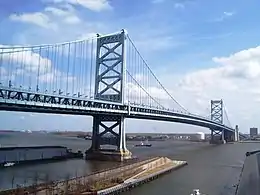
- New Hope–Lambertville Toll Bridge[39]
- Scudder Falls Bridge
- Delaware River – Turnpike Toll Bridge
- Burlington–Bristol Bridge
- Tacony–Palmyra Bridge
- Betsy Ross Bridge
- Benjamin Franklin Bridge
- Walt Whitman Bridge
- Commodore Barry Bridge
- Delaware Memorial Bridge
Airports
Major:
- Philadelphia International Airport (PHL), located 15 miles southwest of Center City Philadelphia, is the main international airport serving the immediate Delaware Valley Area
- Newark Liberty International Airport (EWR), while not in the Delaware Valley, is a major airport serving certain regions of the Delaware Valley, including Bucks, Montgomery County, the city of Philadelphia as well as New Jersey.
Secondary:
- Atlantic City International Airport (ACY)
- Lehigh Valley International Airport (ABE) (not in CSA)
- New Castle Airport (ILG)
- Northeast Philadelphia Airport (PNE)
- Reading Regional Airport (RDG)
- Trenton–Mercer Airport (TTN) (not in CSA)
Ferry
The Cape May–Lewes Ferry crosses the mouth of the Delaware Bay between Cape May County, NJ and Sussex County, DE. U.S. Route 9 uses this ferry.
Colleges and universities
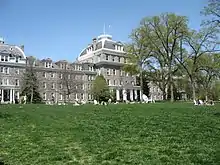
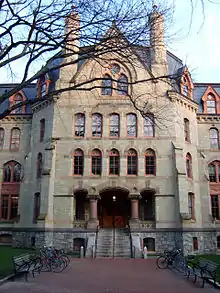
Delaware
- Delaware College of Art and Design
- Delaware State University
- Goldey-Beacom College
- University of Delaware
- Wesley College
- Widener University School of Law
- Wilmington University
Maryland
- Cecil College
New Jersey
- Rider University
- Rowan University
- Rutgers School of Law–Camden
- Rutgers University (Camden)
- Stockton University
- The College of New Jersey
Pennsylvania
- Albright College
- Alvernia University
- Arcadia University
- Bryn Mawr College
- Cabrini College
- Cairn University
- Chestnut Hill College
- Cheyney University of Pennsylvania
- Curtis Institute of Music
- Delaware Valley University
- DeVry University
- Drexel University
- Eastern University
- Gwynedd-Mercy College
- Harcum College
- Haverford College
- Holy Family University
- Immaculata University
- Kutztown University of Pennsylvania
- La Salle University
- Lincoln University
- Manor College
- Moore College of Art and Design
- Neumann University
- Peirce College
- Penn State Abington
- Penn State Berks
- Penn State Brandywine
- Penn State Great Valley
- Philadelphia College of Osteopathic Medicine
- Point Park University
- Rosemont College
- Saint Joseph's University
- Swarthmore College
- Temple University
- Thomas Jefferson University
- University of Pennsylvania
- University of the Arts (Philadelphia)
- University of the Sciences in Philadelphia
- Ursinus College
- Valley Forge Christian College
- Valley Forge Military Academy and College
- Villanova University
- West Chester University
- Westminster Theological Seminary
- Widener University
Culture
Sports teams

Listing of the professional sports teams in the Delaware Valley
- National Basketball Association (NBA)
- Major League Baseball (MLB)
- Minor League Baseball (MiLB)
- Jersey Shore BlueClaws
- Reading Fightin Phils
- Wilmington Blue Rocks
- National Football League (NFL)
- National Hockey League (NHL)
- Major League Soccer (MLS)
- Philadelphia Union
- NBA G League
- Delaware Blue Coats
- National Lacrosse League (NLL)
- Philadelphia Wings
Media
The two main newspapers are The Philadelphia Inquirer and the Philadelphia Daily News, owned by the Philadelphia Media Network. Local television channels include KYW-TV 3 (CBS), WPVI 6 (ABC), WCAU 10 (NBC), WHYY-TV 12 (PBS), WPHL-TV 17 (MyNetworkTV), WTXF 29 (FOX), WPSG 57 (CW), and WPPX 61 (Ion). Radio stations serving the area include: WRTI, WIOQ, WDAS (AM), and WTEL.
Area codes
- 215/267/445: The City of Philadelphia and some of its northern suburbs
- 610/484: Southeastern Pennsylvania outside Philadelphia, including the western suburbs, the Lehigh Valley, and most of Berks County
- 856: Southwestern New Jersey, including Camden, Cherry Hill, and Vineland
- 609/640: Central and Southeastern New Jersey, including Trenton, Atlantic City and the southern Jersey Shore
- 302: Delaware
- 410/443/667: Eastern half of Maryland, including Cecil County
- 717: South Central Pennsylvania, including Western Berks County
Politics
Philadelphia itself is heavily Democratic, having voted for the Democratic candidate in every presidential election since 1936. The surrounding suburban counties are key political areas in Pennsylvania, which itself is an important swing state in federal politics.[41] South Jersey has consistently voted Democratic at the presidential level in recent years, although the region is slightly more Republican-leaning than North Jersey and has voted for Republicans at the state and local level.[42] New Castle County's Democratic lean and large share of Delaware's population has tended to make Delaware as a whole vote for Democrats, while the less populous Kent County is more competitive.[43] Recent well-known political figures from the Greater Philadelphia area include current U.S. President Joe Biden, former Pennsylvania Governor Ed Rendell and late former U.S. Senator Arlen Specter.
Congressional districts
The following congressional districts of the United States House of Representatives are located partly or entirely in the Delaware Valley CSA. Italicized counties are not part of the CSA.
| District | Incumbent | |||
|---|---|---|---|---|
| District | PVI | Incumbent | Party | Counties |
| DE-AL | D+6 | Lisa Blunt Rochester | D | Kent, New Castle, and Sussex |
| MD-1 | R+14 | Andy Harris | R | Baltimore, Caroline, Carroll, Cecil, Dorchester, Harford, Kent, Queen Anne's, Somerset, Talbot, Wicomico, and Worcester |
| NJ-1 | D+13 | Donald Norcross | D | Burlington, Camden, and Gloucester |
| NJ-2 | R+1 | Jeff Van Drew | R | Atlantic, Burlington, Camden, Cape May, Cumberland, Gloucester, Ocean, and Salem |
| NJ-3 | R+2 | Andy Kim | D | Burlington and Ocean |
| PA-1 | R+1 | Brian Fitzpatrick | R | Bucks and Montgomery |
| PA-2 | D+25 | Brendan Boyle | D | Philadelphia |
| PA-3 | D+41 | Dwight Evans | D | Philadelphia |
| PA-4 | D+7 | Madeleine Dean | D | Berks and Montgomery |
| PA-5 | D+13 | Mary Gay Scanlon | D | Delaware, Montgomery, and Philadelphia |
| PA-6 | D+2 | Chrissy Houlahan | D | Berks and Chester |
| PA-9 | R+14 | Dan Meuser | R | Berks, Carbon, Columbia, Lebanon, Luzerne, Montour, Northumberland, and Schuylkill |
Additionally, the Delaware Valley is represented in the United States Senate by the eight Senators from Delaware, Maryland, New Jersey, and Pennsylvania.
See also
- Central Delaware Valley AVA
- Delaware Valley Railway
- Northeast megalopolis
- Mid-Atlantic states
Notes
- May also be defined as part of the NYC Metropolitan Area
- Mean monthly maxima and minima (i.e. the highest and lowest temperature readings during an entire month or year) calculated based on data at said location from 1991 to 2020.
- Official temperature and precipitation measurements for Philadelphia were taken at the Weather Bureau Office in downtown from January 1872 to 19 June 1940, and at Philadelphia Int'l from 20 June 1940 to the present.[23] Snowfall and snow depth records date to 1 January 1884 and 1 October 1948, respectively.[24] In 2006, snowfall measurements were moved to National Park, New Jersey directly across the Delaware River from the airport.[25]
- Mean monthly maxima and minima (i.e. the highest and lowest temperature readings during an entire month or year) calculated based on data at said location from 1991 to 2020.
- The official climatology station for Atlantic City was at the Weather Bureau Office downtown from January 1874 to 15 June 1958 and Atlantic City Int'l (ACY) in Egg Harbor Township since 16 June 1958.[29] ACY's location in the Pine Barrens and distance away from the coast and urban heat island of downtown Atlantic City largely account for its markedly colder temperatures at night as compared to downtown; for example, from 1959 to 2013, there were 50 days with a low of 0 °F (−18 °C) or lower, while in the same period, the corresponding number of days at downtown was 2. The National Weather Service ceased regular snowfall observations at downtown after the winter of 1958–59.
References
- "Welsh Mountain". Retrieved May 5, 2016.
- "MyTopo – Welsh Mountain area". Retrieved May 5, 2016.
- "Words and Their Stories: Nicknames for Philadelphia and Boston". Voice of America. Retrieved July 11, 2017.
- "Best National University Rankings". U.S. News & World Report. January 1, 2022. Retrieved April 27, 2022.
- "2022 Best Global Universities Rankings". U.S. News & World Report. January 1, 2022. Retrieved January 1, 2022.
- "QS World University Rankings 2022". Top Universities. January 1, 2022. Retrieved April 27, 2022.
- Tucker, Laura (November 25, 2014). "Philadelphia". QS Quacquarelli Symonds Limited. Retrieved October 11, 2015.
- Eramian, Daniel (November 2, 2020). "Is Philadelphia's biotech cluster faltering? Experts say no". STAT. Retrieved October 24, 2021.
- (Note: Mercer County, NJ is NOT part of the Philadelphia CSA according to this original source.) "Revised Delineations of Metropolitan Statistical Areas, Micropolitan Statistical Areas, and Combined Statistical Areas, and Guidance on Uses of the Delineations of These Areas", OMB Bulletin no. 18-04, The White House, Office of Management and Budget, September 4, 2018
- "Greater Philadelphia Economic Development Framework" (PDF). September 2009. Retrieved January 5, 2018.
- "Annual Estimates of the Resident Population: April 1, 2010 to July 1, 2016". United States Census Bureau. Archived from the original on February 14, 2020. Retrieved December 30, 2017.
- Analysis, US Department of Commerce, BEA, Bureau of Economic. "Bureau of Economic Analysis". www.bea.gov. Retrieved October 4, 2017.
- "Annual Estimates of the Resident Population: April 1, 2010 to July 1, 2016 - United States -- Combined Statistical Area; and for Puerto Rico". United States Census Bureau, Population Division. March 2017. Retrieved April 20, 2016.
- "Local Television Market Universe Estimates" (PDF). Nielsen. The Nielsen Company. September 24, 2016. Retrieved April 11, 2017.
- Bond, Michaelle (November 7, 2017). "In historic win, Delco Dems take council seats". Philly.com. Retrieved January 5, 2018.
- Stirling, Steven (April 24, 2015). "Here are the North, Central and South Jersey borders as determined by you (INTERACTIVE)". NJ.com. Retrieved January 5, 2018.
- "PHILADELPHIA DESIGNATED MARKET DATA". TruckAds. Retrieved January 4, 2018.
- "Community Facts". American FactFinder. United States Census Bureau. Retrieved January 4, 2018.
- "Census 2000 PHC-T-29. Ranking Tables for Population of Metropolitan Statistical Areas, Micropolitan Statistical Areas, Combined Statistical Areas, New England City and Town Areas, and Combined New England City and Town Areas: 1990 and 2000" Table 7, released December 30, 2003. https://www.census.gov/population/www/cen2000/briefs/phc-t29/tables/tab07.pdf Accessed April 22, 2019.
- Office of Management and Budget Bulletin 13-01, 28 February 2013, accessed on 22 April 2019 at URL https://www.bls.gov/bls/omb-bulletin-13-01-revised-delineations-of-metropolitan-statistical-areas.pdf
- "Global Philadelphia". Global Philadelphia Association. Retrieved February 2, 2015.
- "Dominicans in the Delaware Valley". Medgar Evers College. Archived from the original on February 16, 2011. Retrieved May 13, 2010.
- ThreadEx; search for location= "PA - Philadelphia", variable= "Station thread"
- "NowData - NOAA Online Weather Data". National Oceanic and Atmospheric Administration. Retrieved April 13, 2016.
- Wood, Anthony R. "Snow total at airport gets a boost A new measuring station and technique likely contributed to two 8-inch-plus readings". Philly.com. The Inquirer. Archived from the original on July 28, 2014. Retrieved June 10, 2014.
- "Summary of Monthly Normals 1991-2020". National Oceanic and Atmospheric Administration. Retrieved June 13, 2021.
- "WMO Climate Normals for PHILADELPHIA/INT'L ARPT PA 1961–1990". National Oceanic and Atmospheric Administration. Retrieved July 18, 2020.
- "Philadelphia, Pennsylvania, USA - Monthly weather forecast and Climate data". Weather Atlas. Retrieved May 17, 2019.
- Threadex
- "NowData - NOAA Online Weather Data". National Oceanic and Atmospheric Administration. Retrieved August 11, 2021.
- "Station: Atlantic City, NJ". U.S. Climate Normals 2020: U.S. Monthly Climate Normals (1991-2020). National Oceanic and Atmospheric Administration. Retrieved August 11, 2021.
- Average weather for Doylestown Weather Channel Retrieved May 12, 2008
- "Climate Statistics for Reading, Pennsylvania". Retrieved March 10, 2012.
- "Station Name: DE DOVER". National Oceanic and Atmospheric Administration. Retrieved February 28, 2013.
- "NowData - NOAA Online Weather Data". National Oceanic and Atmospheric Administration. Retrieved December 14, 2011.
- "Station Name: DE WILMINGTON NEW CASTLE CO AP". National Oceanic and Atmospheric Administration. Retrieved May 5, 2014.
- Calvin, Claude (1945). The Calvin Families. University of Wisconsin. pp. 47–53, 57–71.
- "New Hope-Lambertville Route 202 Toll Bridge". Delaware River Joint Toll Brice Commission. Archived from the original on February 25, 2015.
- "The 50 best business schools in the world". Business Insider.
- Cohen, Micah (October 29, 2012). "In Pennsylvania, the Democratic Lean Is Slight, but Durable". The New York Times. Retrieved January 5, 2018.
- Cohen, Micah (July 14, 2012). "In Blue New Jersey, Red Spots May Be Sign of the Past". FiveThirtyEight. Retrieved January 5, 2018.
- Cohen, Micah (August 31, 2012). "Delaware: A Small Example of a Larger Trend". FiveThirtyEight. Retrieved January 5, 2018.
Further reading
- Jean R. Soderlund, Lenape Country: Delaware Valley Society before William Penn. Philadelphia: University of Pennsylvania Press, 2014.
- Mark L. Thompson, The Contest for the Delaware Valley: Allegiance, Identity, and Empire in the Seventeenth Century. Baton Rouge, LA: Louisiana State University Press, 2013.
